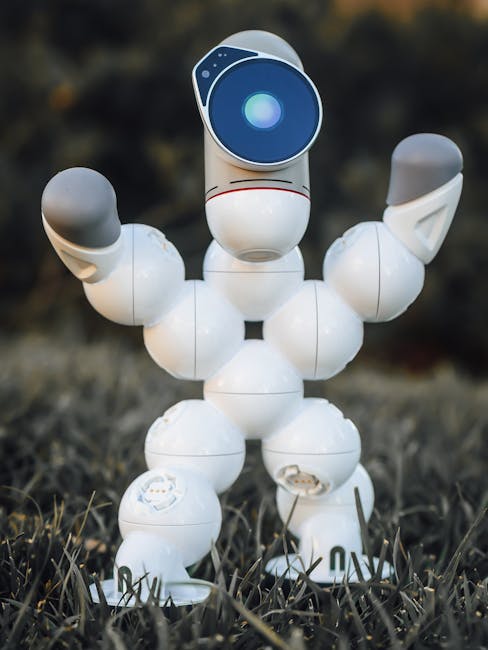The Future of Toys: AI and Robotics in Play
The world of toys is evolving rapidly, and the integration of artificial intelligence (AI) and robotics is reshaping how children play and learn. From interactive dolls to programmable robots, the future of toys is not just about fun but also about fostering creativity and education. In this blog post, we’ll delve into how AI and robotics are transforming playtime, what benefits they offer, and what the future holds for these innovative toys.
Table of Contents
- Introduction
- The Rise of AI Toys
- Benefits of AI and Robotics in Toys
- Educational Opportunities
- Challenges and Concerns
- The Future of AI Toys
- Conclusion
- FAQ
Introduction
Remember the days of simple wooden blocks and teddy bears? While those classics will always hold a special place in our hearts, the toy industry is experiencing a technological revolution. AI and robotics are at the forefront, bringing toys to life in ways we never imagined. Imagine a toy dinosaur that not only walks but also learns your child’s name and responds to their questions. Sounds futuristic? It’s happening now!
The Rise of AI Toys
AI toys have been gaining popularity for their ability to interact with children in dynamic ways. These toys can engage in conversations, adapt to a child’s learning pace, and even express emotions. Robotics, on the other hand, adds a physical dimension, allowing toys to move, dance, and perform tasks.
For instance, AI-powered dolls can now recognize voices, learn new phrases, and interact with children, creating a personalized play experience. Robotic kits, like those from LEGO, enable kids to build their own robots and program them using simple coding languages. These innovations are not just entertaining; they’re educational too.
Benefits of AI and Robotics in Toys
AI and robotics in toys offer numerous benefits:
🌟 Interactive Learning: These toys provide interactive learning experiences, helping children develop problem-solving skills and creativity.
🌟 Personalized Play: With AI, toys can adapt to a child’s preferences and learning pace, offering a customized play experience.
🌟 STEM Education: Robotics toys introduce children to the basics of coding and engineering, sparking an interest in STEM fields.
🌟 Emotional Development: By interacting with AI toys, children can improve their emotional intelligence as they learn to express and understand emotions.
Educational Opportunities
AI and robotics toys are perfect tools for enhancing education. They can make complex subjects more accessible and enjoyable for children. For example, a robot that teaches coding can simplify the learning process by turning it into a game. By incorporating storytelling and interactive challenges, these toys make learning fun and engaging.
Furthermore, schools are beginning to integrate these technologies into their curriculums. Robotics clubs and coding workshops are becoming increasingly popular, providing students with hands-on experience that develops critical thinking and teamwork skills.
Challenges and Concerns
Despite the exciting potential, there are challenges and concerns associated with AI and robotics in toys. Privacy is a major issue, as many AI toys collect data to function effectively. Ensuring that this data is protected is crucial to safeguarding children’s privacy.
Additionally, there’s the concern of screen time and dependency. While AI toys can be educational, it’s essential for parents to balance tech-based play with traditional, imaginative activities. Ensuring that children remain active and socially engaged is key.
The Future of AI Toys
The future of AI and robotics in toys is bright. As technology advances, we can expect toys to become even more sophisticated, offering richer and more immersive play experiences. From virtual reality integration to AI companions that grow with your child, the possibilities are endless.
Moreover, as AI becomes more accessible and affordable, these advanced toys will become available to a broader audience, bridging the gap between technology and play for children worldwide.
Conclusion
The integration of AI and robotics in toys is revolutionizing how children play and learn. These toys offer exciting opportunities for education and personal development, making playtime more interactive and meaningful. However, it’s crucial to address the challenges they present, ensuring a safe and balanced approach to tech-driven play.
FAQ
Q1: Are AI toys safe for children?
A1: Yes, AI toys are safe when used under supervision. It’s important for parents to review privacy policies and ensure their child’s data is protected.
Q2: How do AI toys help in education?
A2: AI toys make learning interactive and fun, helping children develop skills in STEM, problem-solving, and emotional intelligence.
Q3: What age group are AI toys suitable for?
A3: AI toys are designed for various age groups, from toddlers to teenagers. Always check the manufacturer’s recommended age before purchase.
Q4: Can AI toys replace traditional toys?
A4: While AI toys offer unique benefits, they shouldn’t replace traditional toys. A balanced mix of both promotes comprehensive development.
Q5: What should parents consider when buying AI toys?
A5: Parents should consider the toy’s educational value, privacy policies, and ensure it aligns with their child’s interests and developmental stage.
